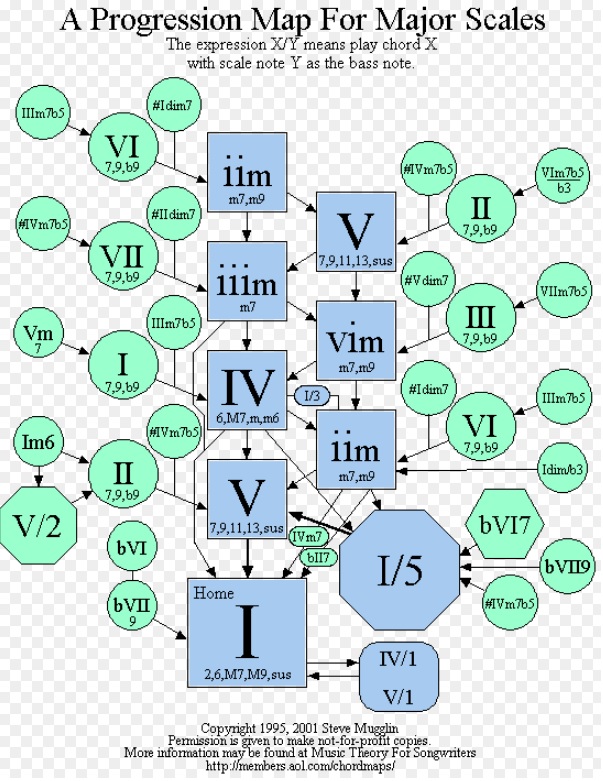Songwriting Tips:
Lots of Them...

HAS THIS EVER HAPPENED TO YOU??
SONGWRITER'S BLOCK!!!!
STYMIED? Here are some songwriting tips which may be of use to you: They include some basic music theory [Don't worry - They are as simple as the alphabet or the counting of numbers.]
Also: some general "rules of thumb" which I know you will find helpful.
Songwriting Tips - General:
ON THE NEED FOR FAMILIARITY IN ART, AND MUSIC:
"A work of art
must in some way model or demonstrate a possible human situation or
experience. Otherwise it will not evoke a response."
"DOES MUSIC [or songwriting] HAVE ANY "RULES"?
This is what the great LEONARD BERNSTEIN has to say on this:
"All music—whether folk, pop, symphonic, modal, tonal, atonal, polytonal, microtonal, well-tempered, ill-tempered, music from the distant past or imminent future—all of it has a common origin in the universal phenomenon of the Harmonic Series."
— LEONARD BERNSTEIN - from "THE UNANSWERED QUESTION" - The Harvard Lectures
[see diagram of how all strings vibrate, below - this is the "origin" of the Harmonic Series]

["aside": I've started listening to his Harvard Lectures, and, wow! Are they intriguing and compelling! I recommend you do the same: Even if you are not an "academic", you CAN get some great insights from them, if you carefully get all the unfamiliar words defined as they come up. This isn't hard, just keep one or more dictionaries open by your side, or on a separate tab.]
Songwriting Tips: Scales, Melody, Harmony, etc:
[On, THE "UNIVERSALITY" of the DIATONIC [Western Music] SCALE:
As, Mr. Bernstein and others have observed, at least as far as Western [hemisphere/European sourced] music is concerned, the overtone series-based musical scales are more likely to be perceived as "music", to people, than 'atonal' or non-overtone-based scales.
This does not, however account for the longevity of non-diatonic music among certain cultures, such as that of Bali. In this case, I myself chalk it up to "agreement" and "expectancy". I. E.: if that's what you grew up with, then THAT'S what music is and sounds like.]
Another Bit of Theory:
You may know that if you double the frequency of a note, you get a note one octave higher, and if you halve that frequency, you get a note one octave lower.
And, EVERY note on the "Western" musical scale arrangement has a rather simple relationship to every other note [as shown above].
It's the relationships which give the coherence to the music we are used to hearing as music.
[However, if you are a songwriter, rather than a mathematician, you can bypass the complexity of mathematical formulas without damaging your craft, In my opinion.]
THE "MECHANISMS" OF A POPULAR SONG:
Here are some areas which can all prove helpful to mastering the art of songwriting. I propose that all great songwriters know all of the below, either "instinctively" and/or through study:
*a the various relationships among notes in a scale,
*how these points affect the 'tension' and interest of the melody,
*how the melody works with the chords,
*how the chords work with each other,
*how this all works against the meter, or "pulse" of a song,
*how this all adds up to "song structure",
and so on.
Take a look at the following diagram:

This is a unique way to represent a "perception" of music, known as "TONAL GRAVITY"
The above diagram shows the weak and strong "forces" which "push" [or"pull"] a song back to it's starting point: The 'one' [first note of the scale] or 'tonal center' or 'root' of the scale the song is written in.
The chart works like this: Say you are writing a song in "C". You've gone to "A minor". Well, you can go from A minor to G [moderately strong] to C [relatively weak]. OR.. etc.
I thought of the 4-chord pattern of "DON'T STOP BELIEVIN' as a tremendously powerful demonstration of these "forces" which lie "dormant" in the chords, waiting to be unleashed! :)
Here's another idea: expanding these "tonal gravity" forces, into another arrangement: THE "CHASE CHART" [below]:

It's called a "Chase Chart" because you can "chase" around the circle, clockwise, either in single or multiple "jumps", so as to compose &/or analyze a song. I do like this.
And - I personally think it might be more accessible to somebody just starting out, than something like THIS:

Songwriting Tips: What About Lyrics?
So much for the music. Now, how about LYRICS?
THE "VOCAL-MELODIC PHRASE":
"Words with music, unlike words without music, there are pauses (rests) which break up the "flow" of musical notes and their accompanying words into "vocal-melodic phrases", each consisting of a handful of “note-syllables”— syllables or words (or one-syllable words) sung to individual notes."
Here is an example of the above:
"SomeWHERE* O-ver the RAIN-BOW,
BLUE -- BIRDS -- FLY." ...
*Note that the syllable "-where", is emphasized by the beat and by the melody. However, in normal conversation we would say: "SOME-where." -
A further example:
"PEACE and QUI-et and O-pen AIR,
WAIT for US -- SOME-where."
["Somewhere" - from the Broadway musical: "West Side Story" - Leonard Bernstein/Stephen Sondheim]
In the above example, the sung/musical accent of most every word coincides with the way they are naturally spoken. This is one of STEPHEN SONDHEIM'S principles of lyric writing. [And his track record isn't too bad, hm?]
You can use these ideas to analyze material. Where applicable, they can help uncover where and why weak points in a song exist, and how to fix them. But you also don't have to consider them as "absolute".
Great artists know WHEN to break the rules, and when to keep them.
Songwriting Tips: The Wrap-Up:
In our quests for the "perfect lyric" and "perfect songwriting system", we all continue to hunt around for tips from those who've made a success of songwriting.
But, I Hope these are of use to you.
Here's to Great Songwriting!!
THIS "SECRET METHOD" TO INSTRUMENTAL MASTERY HAS BEEN "HIDDEN IN PLAIN SIGHT" FOR OVER A CENTURY!
But now, it has been REDISCOVERED! And YOU can enjoy the amazing benefits of it:
This Method Book Can ABSOLUTELY "Supercharge" YOUR Practice Routine - on ANY Instrument!
Find out more, or:
Buy It NOW On Amazon [Physical Paperback]:
or:
Get the PDF by clicking here:
"I’ve been playing a long time and really want to take my speed and accuracy to the next level! The first lesson...WOW! I’m a believer!!" ~ Will Suddeth, March 2020
And the accolades continue: David Grisman [above] uses "The Original" Cowling System:
DOWNLOAD "THE ORIGINAL COWLING SYSTEM©" -- PDF "E-BOOK" - 70 pages [$22.50 via PAYPAL secure]
THE SOFTCOVER PHYSICAL BOOK IS BACK IN PRINT! - Available at Amazon.
And still more [actual and unsolicited] rave reviews for "The Original" Cowling System:
-----------------
FROM A VIOLINIST:
"The Cowling System © is a set of 12 exercises designed to increase the flexibility and strength of the hand, wrist, and fingers.
"I bought the course in 1978 and have found them to be invaluable.
"I've kept them all these years and still use them to warm up with before playing."
~ Richard Barton posted on VIOLINIST.COM
-----------------
FROM A BASS PLAYER:
?"My fingers actually DO what my brain tells them to do, WITHOUT getting confused."
~ Anthony Jerome Smith, 35-year veteran bass player.
-----------------
FROM A PIANIST:
"In 1976, my teacher gave me his copy of all the exercises, whereupon I made xeroxed pages to put in a binder.
"My teacher was amazed at my progress that in a year I could play, for example, the prelude #17 of Chopin!
~ "RPN58" (from a pianists' discussion board in England, 2006)
-----------------
FROM A GUITARIST:
"I was introduced to the Cowling System © in the 1980's by a violinist in his seventies, who had amazing dexterity on his instrument for HIS age.
"Through the use of the COWLING SYSTEM ©, I went from "amateur" to an "A" level in music in a very short number of years.
"I have been using the exercises continuously since my friend gave them to me and believe me - THEY WORK."
~ Don Wills Guitarist, Great Britain
-----------------
FROM A VIOLINIST:
"I must say I am highly delighted with the way my fingering has improved since I commenced your hand strengthening exercises.
"Recently, I became very depressed about my playing and almost decided to give it up, but now I feel it's a pleasure, thanks to the Cowling System. ©"
~ "THE VIOLINIST" Magazine, December, 1924
I'd love to see YOUR testimonial on this list! If you really do "THE ORIGINAL" COWLING SYSTEM © of Hand Strengthening Exercises", you CAN master and truly enjoy your music!


